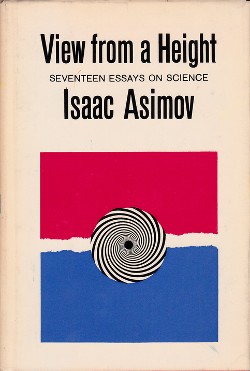 First edition | |
| Author | Isaac Asimov |
|---|---|
| Language | English |
| Series | Fantasy & Science Fiction essays |
| Publisher | Doubleday |
Publication date | September 6, 1963 |
| Publication place | United States |
| Media type | print (Hardback and Paperback) |
| Preceded by | Fact and Fancy |
| Followed by | Adding a Dimension |
View from a Height is a collection of seventeen scientific essays by American writer and scientist Isaac Asimov. It was the second of a series of books collecting essays from The Magazine of Fantasy and Science Fiction , written between 1959 and 1962. It was first published by Doubleday & Company in 1963. The book received a review in Science Magazine . [1] and The American Biology Teacher . [2]
Contents
The collection includes the essay "By Jove!", the source of the Asimov misquote describing the Solar System (besides the Sun) as "Jupiter plus debris". The actual quote is "4 planets plus debris". [3]